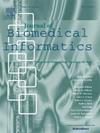Integrating Mendelian randomization and literature-mined evidence for breast cancer risk factors
IF 4
2区 医学
Q2 COMPUTER SCIENCE, INTERDISCIPLINARY APPLICATIONS
引用次数: 0
Abstract
Objective:
An increasing challenge in population health research is efficiently utilising the wealth of data available from multiple sources to investigate disease mechanisms and identify potential intervention targets. The use of biomedical data integration platforms can facilitate evidence triangulation from these different sources, improving confidence in causal relationships of interest. In this work, we aimed to integrate Mendelian randomization (MR) and literature-mined evidence from the EpiGraphDB biomedical knowledge graph to build a comprehensive overview of risk factors for developing breast cancer.
Methods:
We utilised MR-EvE (“Everything-vs-Everything”) data to identify candidate risk factors for breast cancer and generate hypotheses for potential mediators of their effect. We also integrated this data with literature-mined relationships, which were extracted by overlapping literature spaces of risk factors and breast cancer. The literature-based discovery (LBD) results were followed up by validation with two-step MR to triangulate the findings from two data sources.
Results:
We identified 129 novel and established lifestyle risk factors and molecular traits with evidence of an effect on breast cancer, and made the MR results available in an R/Shiny app (https://mvab.shinyapps.io/MR_heatmaps/). We developed an LBD approach for identifying potential mechanistic intermediates of identified risk factors. We present the results of MR and literature evidence integration for two case studies (childhood body size and HDL-cholesterol), demonstrating their complementary functionalities.
Conclusion:
We demonstrate that MR-EvE data offers an efficient hypothesis-generating approach for identifying disease risk factors. Moreover, we show that integrating MR evidence with literature-mined data may be used to identify causal intermediates and uncover the mechanisms behind the disease.

整合孟德尔随机化和文献挖掘乳腺癌危险因素的证据。
目的:有效利用多种来源的丰富数据来调查疾病机制并确定潜在的干预目标,是人口健康研究面临的一个日益严峻的挑战。使用生物医学数据整合平台可以促进来自这些不同来源的证据三角化,提高对相关因果关系的信心。在这项工作中,我们旨在整合孟德尔随机化(MR)和来自EpiGraphDB生物医学知识图谱的文献挖掘证据,以建立一个全面的乳腺癌危险因素概述。方法:我们利用MR-EvE(“Everything-vs-Everything”)数据来确定乳腺癌的候选危险因素,并对其影响的潜在中介产生假设。我们还将这些数据与文献挖掘的关系结合起来,这些关系是通过重叠的危险因素和乳腺癌的文献空间提取的。基于文献的发现(LBD)结果随后通过两步磁共振验证,从两个数据源对结果进行三角测量。结果:我们确定了129种新的和已建立的生活方式风险因素和分子特征,这些因素和特征有证据表明对乳腺癌有影响,并在R/Shiny应用程序(https://mvab.shinyapps.io/MR_heatmaps/)中提供了MR结果。我们开发了一种LBD方法来识别识别风险因素的潜在机械中间体。我们介绍了两个案例研究(儿童体型和高密度脂蛋白胆固醇)的MR结果和文献证据整合,证明了它们的互补功能。结论:我们证明MR-EvE数据为识别疾病危险因素提供了一种有效的假设生成方法。此外,我们表明,将MR证据与文献挖掘的数据相结合,可用于识别因果中介并揭示疾病背后的机制。
本文章由计算机程序翻译,如有差异,请以英文原文为准。
求助全文
约1分钟内获得全文
求助全文
来源期刊

Journal of Biomedical Informatics
医学-计算机:跨学科应用
CiteScore
8.90
自引率
6.70%
发文量
243
审稿时长
32 days
期刊介绍:
The Journal of Biomedical Informatics reflects a commitment to high-quality original research papers, reviews, and commentaries in the area of biomedical informatics methodology. Although we publish articles motivated by applications in the biomedical sciences (for example, clinical medicine, health care, population health, and translational bioinformatics), the journal emphasizes reports of new methodologies and techniques that have general applicability and that form the basis for the evolving science of biomedical informatics. Articles on medical devices; evaluations of implemented systems (including clinical trials of information technologies); or papers that provide insight into a biological process, a specific disease, or treatment options would generally be more suitable for publication in other venues. Papers on applications of signal processing and image analysis are often more suitable for biomedical engineering journals or other informatics journals, although we do publish papers that emphasize the information management and knowledge representation/modeling issues that arise in the storage and use of biological signals and images. System descriptions are welcome if they illustrate and substantiate the underlying methodology that is the principal focus of the report and an effort is made to address the generalizability and/or range of application of that methodology. Note also that, given the international nature of JBI, papers that deal with specific languages other than English, or with country-specific health systems or approaches, are acceptable for JBI only if they offer generalizable lessons that are relevant to the broad JBI readership, regardless of their country, language, culture, or health system.
 求助内容:
求助内容: 应助结果提醒方式:
应助结果提醒方式:


